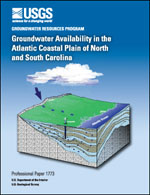The Atlantic Coastal Plain aquifers and confining units of North and South Carolina are composed of crystalline carbonate rocks, sand, clay, silt, and gravel and contain large volumes of high-quality groundwater. The aquifers have a long history of use dating back to the earliest days of European settlement in the late 1600s. Although extensive areas of some of the aquifers have or currently (2009) are areas of groundwater level declines from large-scale, concentrated pumping centers, large areas of the Atlantic Coastal Plain contain substantial quantities of high-quality groundwater that currently (2009) are unused.
Groundwater use from the Atlantic Coastal Plain aquifers in North Carolina and South Carolina has increased during the past 60 years as the population has increased along with demands for municipal, industrial, and agricultural water needs. While North Carolina and South Carolina work to increase development of water supplies in response to the rapid growth in these coastal populations, both States recognize that they are facing a number of unanswered questions regarding availability of groundwater supplies and the best methods to manage these important supplies.
An in-depth assessment of groundwater availability of the Atlantic Coastal Plain aquifers of North and South Carolina has been completed by the U.S. Geological Survey Groundwater Resources Program. This assessment includes (1) a determination of the present status of the Atlantic Coastal Plain groundwater resources; (2) an explanation for how these resources have changed over time; and (3) development of tools to assess the system's response to stresses from potential future climate variability. Results from numerous previous investigations of the Atlantic Coastal Plain by Federal and State agencies have been incorporated into this effort.
The primary products of this effort are (1) comprehensive hydrologic datasets such as groundwater levels, groundwater use, and aquifer properties; (2) a revised hydrogeologic framework; (3) simulated water budgets of the overall study area along with several subareas; and (4) construction and calibration of a numerical modeling tool that is used to forecast the potential effects of climate change on groundwater levels.


